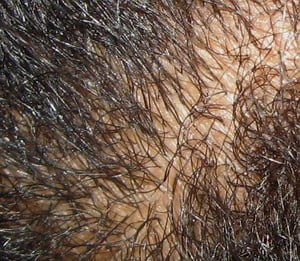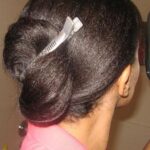As I have inched a few years past the age of thirty, I have noticed an obvious sign that age is starting to creep up on me a bit: my forehead seems to be getting bigger! At first, I just passed it off as bad lighting, a dirty mirror, or the results of a funny haircut. However, as I have examined my hairline with a more realistic and unbiased eye, I have come to the conclusion that indeed my hairline has started to move north. I recently viewed a picture of myself from when I was twenty-four years old, and I was literally spooked at how low my hairline appeared back then as opposed to my current age. Now, I don’t want you to get the wrong impression and start thinking that I’m some sort of a looks-obsessed guy; I’m not! I’ve never had a manicure or a pedicure in my life. I’ve never been to a day spa, I’ve never had a facial, and I don’t spend an obscene amount of time fussing about my appearance. However, I have always valued my hair. I think that having a full head of hair should be a natural right; having a full head of hair and a strong hairline is healthy and normal. So, in my eyes, the fact that I’m more than a little concerned with my retreating hairline is not a sign of weakness or insecurity on my part, but a sign that I have a healthy sense of right and wrong. And, having a full head of hair is right; it’s how a person’s head is supposed to be – fully covered in hair! Hair on top of the head – besides being pleasing to the eye – serves a purpose; it keeps us warm, it shields our heads from the elements, e.t.c.
Now, I don’t want to make it sound like I spend every minute of every single day stressing about my hairline; I don’t! But, It is something that I think about a lot. And it is something that I have vowed to fight. Every time I pass a person on the street who has a shiny head minus the requisite hair cover, I start to experience a sense of urgency in combating my own hair loss. I have a lot of bald relatives; all of my uncles are balding or bald, and both my paternal and fraternal grandfathers were bald. Just stating this simple fact about my family history causes me to wince slightly, as I know that the baldness that runs in my family does not bode well for my hopes of growing old both gracefully and with a full head of hair. I know all about genetics and how certain genes get passed down from generation to generation, so, in examining my family tree, I realize that my particular tree is filled with a lot of branches that are missing their leaves, and I stand a good chance of ending up as one of those bare branches. Not that there is anything wrong with that per se, but for me, I value my hair too much to give in to genetics without a fight! There are many people who look good with a bald head or with a receding hairline, and I take my hat off to those people; it’s a style that works for many. But I can’t see myself with a bare, shiny head. I don’t have the right head shape to make it work.
So, in my effort to put a stop to the dire things that are going on with my hair, I have vested a lot of hope(and money) in modern medicine. After determining that my hairline was, in fact, receding, I made an appointment with my personal physician and was promptly sent on my merry way with a prescription for Propecia, which is one of only two medicines that have been approved by the FDA to combat hair loss. In a nutshell, Propecia works by reducing the levels of DHT in the body, which is a by-product of testosterone synthesis. DHT(di-hyrdo-testosterone) exerts its effects on the human scalp by causing the hair follicles to shrivel up; after a prolonged period of exposure to DHT, the hair follicles eventually die. Ironically, DHT is the same chemical that causes a man’s prostate to enlarge. Propecia actually started out as a treatment for men with enlarged prostates, and during the course of treatment for prostate enlargement, many men who were bald or balding actually started to regrow hair! Propecia is a tablet that is taken orally, once a day. The only other drug that has FDA approval as a hairloss remedy is Minoxidil, which is marketed as Rogaine. Rogaine is available as a liquid or a foam which is applied to the affected areas of the scalp. Of the two medications, Propecia has a stronger track record fighting hair loss. Also, Propecia treatment is much easier; you simply pop a pill every day and that’s it. With Rogaine, you have to bother with the mess of applying a liquid or foam to your hair and then waiting for it to dry. Many people use both medications together; sort of a one-two punch in the fight against hair loss. I may end up following the same course of treatment, but for now, I am going to give Propecia adequate time to exert its effects before adding another medication.
I have been on Propecia for almost a year now, and I can say that my hair loss does not seem to have progressed. I still have a lot of hair; the only obvious problem is my hairline, which has obviously receded from its original location. So, time will tell as to the course that my hair loss and hair loss treatments will take. In the world of hair loss treatment, no further hair loss after starting a hair loss treatment is a success. Actually regrowing some of your lost hair is even better, but preventing further hair loss is definitely an achievement. And so far I seem to have achieved that.





